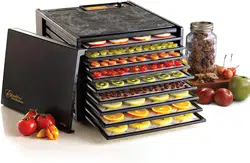Loading ...
Loading ...
Loading ...

19
containers and cover. Incubate in the dehydrator at 115ºF/46ºC for 5 hours. (Note: Use a
candy thermometer for best results.) Do not disturb, bump, open door or move while yogurt
is incubating. When finished, refrigerate. Before serving, add flavors or fresh fruit, if desired.
Cheese
Cottage cheese got its name from the fact it is so easily made in the home…or in the
cottage. Unripened cheese, such as cottage cheese, can be made in your Excalibur
®
dehydrator. To make this cheese, you’ll need a gallon of pasteurized milk and either 4
tablespoons of unflavored yogurt, 1/2 cup fresh buttermilk, or 1/4 tablet of rennet dissolved
in 1/2 cup warm water.
Pour the milk into a crock and warm it to room temperature, about 72ºF/22ºC. Mix in the
yogurt, buttermilk, or rennet and cover the crock with cheesecloth. Place the crock in the
dehydrator and hold the temperature inside at 85ºF/29ºC and 12 to 18 hours until clabbered.
Clabbering means that the milk has separated to form thick, solid “curd” and the watery,
liquid “whey.” When the milk has thickened into curds and little whey lays on the surface,
the cheese is clabbered.
Next, cut the curd as follows. Use a long bladed knife and make all cuts approximately
1/2” apart.
1. Holding the knife vertically, make straight up and down cuts across the curd.
2. Now slant the knife and make diagonal slices down through the cheese following the
cuts of step 1, make the first cut at a 45º angle but gradually straighten the blade so
that the last cut is nearly vertical.
3. Repeat the process in step 2, only slant the knife in the opposite direction.
4. Turn the crock 180º and make a final set of vertical cuts to form a crosshatch
pattern on the surface. This process helps the sour whey drain out.
Place several inches of water in a large pan, set the crock in it and heat to 115ºF/46ºC. Hold the
cottage cheese at this temperature for 1/2 hour, stirring occasionally. Once the time is up, line a
colander with cheesecloth and pour in the curds and whey. Allow the whey to drain off; otherwise,
it will give the cottage cheese a bitter taste. To get rid of even more of the sour taste, dip the
colander in cold water and gently stir the curds to wash away the last traces of the whey. Let
the curds drain thoroughly. If desired, add 1 teaspoon salt per pound of cottage cheese and 4-6
tablespoons of cream. After refrigeration, your cottage cheese will be ready to eat as is or
in fruit salads, dips, cheesecake and casseroles.
In addition to using your dehydrator to make soft cheeses, semi-soft and hard cheeses also
can be made. There are between 700 and 2000 kinds of cheese and instructions for making
them would become a book in itself! Preserve it, Naturally! has “how-to’s” for making semi-
soft and hard cheeses in your Excalibur
®
dehydrator.
Drying Photographs
To dry photographs, treat and wash as usual. Shake or squeegee off the excess liquid and
place on the drying trays. Dry until no wet spots remain. Note: Dry only photographs that
have been printed on resin-water stock. Other types will wrinkle unless pressed flat.
Whole Meal Preparation
Outdoor enthusiasts will want to use the dehydrator to prepare whole meals that need only
to be rehydrated. Dried meats combined with powdered tomato and dried vegetable bits
can be mixed with dried pasta and cooked in a kettle over the campfire for a “gourmet”
after-hiking dinner! A bit of creativity and knowledge of required rehydration time is all that
is needed to devise recipes for lightweight and nutritious take-along meals.
Loading ...
Loading ...
Loading ...
